Caryn
 Of course, they aren’t really angels, but rather they are God’s laborers on earth…the everyday people who find themselves at the right place, at the right time, to save the life of another person. What each contributed was different, but each contribution was vital to the saving of my husband, Bob Schulenberg’s life that October 14, 2018. God tells each of us things we need to know, and if we are listening, we can find ourselves suddenly in the middle of a life or death situation, in which we have the unique ability to do the right things to stave off death for another human being. It is a mind blowing revelation, but it is nevertheless, a reality.
Of course, they aren’t really angels, but rather they are God’s laborers on earth…the everyday people who find themselves at the right place, at the right time, to save the life of another person. What each contributed was different, but each contribution was vital to the saving of my husband, Bob Schulenberg’s life that October 14, 2018. God tells each of us things we need to know, and if we are listening, we can find ourselves suddenly in the middle of a life or death situation, in which we have the unique ability to do the right things to stave off death for another human being. It is a mind blowing revelation, but it is nevertheless, a reality.
That was the position Bob’s Heaven sent Earthly Angels found themselves in. In an instant, my husband went from loading the groceries in the car and returning the cart to the cart stand, to lying on the ground in the Walmart parking lot, blood running from his head, his skin turning purple, and his eyes open, but not seeing. For all intents and purposes, Bob was dead. But God had a different plan. God’s servant, Sean Pesicka-Taggart saw my husband fall, and immediately rushed to his side, trying to wake him. I was in the car, and heard him speaking, but it didn’t occur to me that he was talking to my husband. A pickup pulled up behind us. In the pickup was Ginger Sims, a nurse working at Wyoming Medical Center at the time. She thought Bob had been hit by a car. She pulled around to park her car and assist, telling her son to press the OnStar and get an ambulance coming. Finally, with things in place to save Bob’s life, a man knocked on my window to ask if I knew “this man.” It finally dawned on me that it was Bob. I believe God intentionally stalled my awareness so I would not be alone with the situation. As I jumped out of  the car and saw my husband, I immediately thought I was going to lose him, but then I stubbornly said, “No!!” Then I got down beside him telling him to wake up…”Come on Bob!!” Ginger heard me talking to him and asked if I knew him. Upon finding out he was my husband, she instructed me in rescue breathing. By now she was getting tired, and suddenly, Laura Lance, Sean’s girlfriend, and a transport worker at Wyoming Medical Center said that she knew CPR and so she spelled Ginger. Then, Valya Boycheva, another nurse at Wyoming Medical Center was leaving Walmart, and saw what was happening. She turned around, came back, and also assisted in CPR. Before I knew it, the ambulance summoned by both Ginger’s son and Sean, was there. I remember thinking how amazing it was that all this was taken care of with almost no effort on my part. And the reality is that it was only about five to seven minutes. How could so much activity have been crammed into that tiny sliver of time? Little did I know that there was more. As they were leaving Walmart, Chelsea and Zack Kessler saw what was happening, and began to pray. Chelsea called her dad, Scott Le Page and his wife, Donna, who also prayed. Lori DeSanti was leaving Walmart too, and she began to pray. These people were an extra amazement, because I knew them all, and yet they had no idea who they were praying for, and I had no idea they were praying. God just sent them there to pray, and they obeyed the call. The fire trucks also came to Bob’s assistance, and we knew one of the firefighters, Jerod Levin, because Bob had worked on the fire trucks when he worked for the City of Casper. Jerod took care of me…which I needed very much. He got me into the ambulance, so I could go with Bob, and then he took the time to bring my car to the hospital for me so I would
the car and saw my husband, I immediately thought I was going to lose him, but then I stubbornly said, “No!!” Then I got down beside him telling him to wake up…”Come on Bob!!” Ginger heard me talking to him and asked if I knew him. Upon finding out he was my husband, she instructed me in rescue breathing. By now she was getting tired, and suddenly, Laura Lance, Sean’s girlfriend, and a transport worker at Wyoming Medical Center said that she knew CPR and so she spelled Ginger. Then, Valya Boycheva, another nurse at Wyoming Medical Center was leaving Walmart, and saw what was happening. She turned around, came back, and also assisted in CPR. Before I knew it, the ambulance summoned by both Ginger’s son and Sean, was there. I remember thinking how amazing it was that all this was taken care of with almost no effort on my part. And the reality is that it was only about five to seven minutes. How could so much activity have been crammed into that tiny sliver of time? Little did I know that there was more. As they were leaving Walmart, Chelsea and Zack Kessler saw what was happening, and began to pray. Chelsea called her dad, Scott Le Page and his wife, Donna, who also prayed. Lori DeSanti was leaving Walmart too, and she began to pray. These people were an extra amazement, because I knew them all, and yet they had no idea who they were praying for, and I had no idea they were praying. God just sent them there to pray, and they obeyed the call. The fire trucks also came to Bob’s assistance, and we knew one of the firefighters, Jerod Levin, because Bob had worked on the fire trucks when he worked for the City of Casper. Jerod took care of me…which I needed very much. He got me into the ambulance, so I could go with Bob, and then he took the time to bring my car to the hospital for me so I would  have a way home later.
have a way home later.
God’s Earthly Angels. No, they were just people, but God gave them the opportunity to act at a time when their own special skills were desperately needed to save the life of a man most of them didn’t even know. When we think of angels, we think of beings who go to battle for us, when we need them most. That is exactly what these people did, so I guess angels is an appropriate word for them. All is know is that I…we, Bob and I, as well as our families, are forever indebted to these wonderful people who went to battle that day in the Eastside Walmart parking lot in Casper, Wyoming to fight for the life of my precious husband, Bob…and praise God…they won!!
 My nephew, Ryan Hadlock is a Compression Operator at Fleur de Lis (FDL), which used to be Anadarko, where his Uncle Mike Stevens also works. They have enjoyed working together, even though they are in different areas of the company. Ryan works on the natural gas side, and I believe Mike is on the oil side. Ryan’s job is to maintain the compressors, making sure they work right, Fixing them when they don’t, taking readings, etc. Ryan enjoys his job, and even picks up extra shifts once in a while. His job has been good to him, and has afforded them the money they need to live the life they want to.
My nephew, Ryan Hadlock is a Compression Operator at Fleur de Lis (FDL), which used to be Anadarko, where his Uncle Mike Stevens also works. They have enjoyed working together, even though they are in different areas of the company. Ryan works on the natural gas side, and I believe Mike is on the oil side. Ryan’s job is to maintain the compressors, making sure they work right, Fixing them when they don’t, taking readings, etc. Ryan enjoys his job, and even picks up extra shifts once in a while. His job has been good to him, and has afforded them the money they need to live the life they want to.
Ryan has always been an outdoorsman. He and his dad, Chris have gone fishing, and camping, and they both love sports of all kinds too. Ryan and his wife, Chelsea 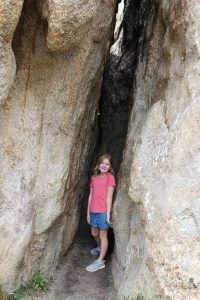 decided to buy a new fifth-wheel trailer this year, and since then, they have gone camping crazy. Most weekends find them and their kids, Ethan and Aurora on the road headed somewhere to go camping. They have taken several great trips this past summer, and my husband, Bob and I got to meet up with them in the Black Hills for the Custer Fireworks Display. We joined them and Ryan’s sister, Jessi her husband, Jason, and their daughter, Adelaide too. Ryan, Chelsea, and the kids also made trips around Wyoming and into Colorado. They all had a wonderful time, and we felt honored to get to join them for part of it.
decided to buy a new fifth-wheel trailer this year, and since then, they have gone camping crazy. Most weekends find them and their kids, Ethan and Aurora on the road headed somewhere to go camping. They have taken several great trips this past summer, and my husband, Bob and I got to meet up with them in the Black Hills for the Custer Fireworks Display. We joined them and Ryan’s sister, Jessi her husband, Jason, and their daughter, Adelaide too. Ryan, Chelsea, and the kids also made trips around Wyoming and into Colorado. They all had a wonderful time, and we felt honored to get to join them for part of it.
Ryan is a happy guy…mostly I’m sure, because her is happily married and has the family he always wanted. He keeps things lively with is jokes and teasing, and his kids are learning to joke and tease. Ryan and Chelsea find it hard to believe that Ethan is in 8th grade and Aurora is in 4th grade. Where have all the years gone. Time flies when you are having fun, and the Hadlock family is definitely having fun.
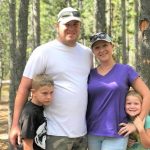
Ryan and Chelsea have been doing home Bible studies with their kids this summer, and the whole family is really growing spiritually. The study is designed to make a relationship with God, a personal thing for each of them, and it has been very successful. The kids have been telling my sister, Allyn Hadlock, who is their grandma, just how much they have learned. This has been an especially enlightening study for Ethan and Aurora, who have been telling their grandma all about how good God is. It is always an important thing for the husband in a family to take the spiritual lead, and Ryan has done that very well. We are very proud of him in this endeavor. Today is Ryan’s birthday. Happy birthday Ryan!! Have a great day!! We love you!!
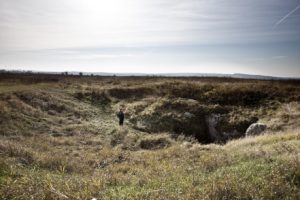 During World War II, and Jews who didn’t want to entrust their survival to the Nazis, had to make a way of escape or find a place to hide. For those who hoped against hope that the Nazis didn’t really hate them, or that the war would end very soon, the chance to escape came and went before they had really given the situation much thought. This was especially true for the Jewish people who had been born in the countries they now found themselves outcasts of.
During World War II, and Jews who didn’t want to entrust their survival to the Nazis, had to make a way of escape or find a place to hide. For those who hoped against hope that the Nazis didn’t really hate them, or that the war would end very soon, the chance to escape came and went before they had really given the situation much thought. This was especially true for the Jewish people who had been born in the countries they now found themselves outcasts of.
Zaida Stermer, his wife Esther, and their six children, of Korolowka, Ukraine, dug up the last of their possessions from behind their house, loaded their wagons with food and fuel, and drove away into the darkness. It was October 12, 1942. The Stermers weren’t alone. Traveling with them were about two dozen friends and family members, all Jews…and all in a lot of trouble. They had almost waited too long, and now the Nazis were out to kill all the Jews in the village. Ukraine had been under German occupation for about a year by then, and they had hoped that the war would end, and they could get back to their lives, but instead, the situation was exploding, and they had to get out while they still could.
The group made their way quietly about 5 miles to the north of town. With the Nazi “roundups and mass executions” of Ukrainian Jews in full swing, they were headed to a dirt road that ended at a sinkhole. There they made their way into a summertime tourist attraction known as the Verteba cave. They knew this was only 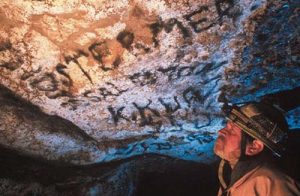 going to be a temporary solution, because in the summer, the tourists would be back, and they would be discovered. They hoped they had until summer.
going to be a temporary solution, because in the summer, the tourists would be back, and they would be discovered. They hoped they had until summer.
Modern cave explorers would not consider going underground without reliable light sources, technical and safety gear, navigation experience, clothing to stave off hypothermia, and of course an adequate supply of food and fresh water. The Stermers and their little band of survivors had none of these things. They went in in the dark, and had no light in the morning either. They fumbled their way further and further into the cave, hoping they could find there way back out. The cave had little ventilation and no real water supply, except what seeped through the rocks. Cooking was dangerous, and they almost lost a child to smoke inhalation. They moved the cooking further into the cave where they found better ventilation. Then came the worst night of all…
They had been in Verteba about four weeks, and thinking they might make it when their optimism was shattered. Suddenly in the dark they heard the sound of boots, and the rattling of guns. Someone yelled in Yiddish, “The Germans are here!! They’ve discovered us!!” Just as suddenly, and before anyone could think twice, Ester spoke up, “Very well, so you have found us. What do you think? Do you think that unless you kill us the Fuhrer will lose the war? Look at how we live her, like rats. All we want is to live, to survive the war years. Leave us here.” She was stalling!! She was allowing the others time to escape. As the stunned Germans listened to this little lady, the others hurried to the escape route they had found earlier. In the end, the 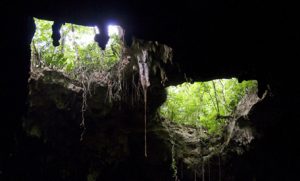 Germans only got eight of the cave dwelling Jews. Miraculously, Esther escaped. They hid out with friends throughout April 1943, but things were heating up again, and Esther told her family, “We are not going to the slaughterhouse.” She said to her son, Nissel, “Go to the forest, find a hole, anything.” It was thanks to Nissel that the family survived. Nissel located the cave known as the Priest’s Grotto. It was thought that the world record for living underground was 205 days, but the true record was set by the women and children who survived the Priest’s Grotto, by living completely underground for 344 days without seeing the outside world. It was a tough way to live, but they did survive, and that is a miracle.
Germans only got eight of the cave dwelling Jews. Miraculously, Esther escaped. They hid out with friends throughout April 1943, but things were heating up again, and Esther told her family, “We are not going to the slaughterhouse.” She said to her son, Nissel, “Go to the forest, find a hole, anything.” It was thanks to Nissel that the family survived. Nissel located the cave known as the Priest’s Grotto. It was thought that the world record for living underground was 205 days, but the true record was set by the women and children who survived the Priest’s Grotto, by living completely underground for 344 days without seeing the outside world. It was a tough way to live, but they did survive, and that is a miracle.

 I first met my nephew, Riley Birky, when he was 9 years old, and his mom, Rachel Schulenberg married my brother-in-law, Ron Schulenberg. Over the years that he has been in our family, Riley has gone through the fairly typical years of a kid, with the teen years being typically the most tumultuous, as is the case with most teens. While those were tough times for Riley, one thing that you could always count on, was that you could always count on Riley. Riley might not have always been excited about helping out, but if he said he would help you with something, he would. He always had a tendency to take care of everybody before himself. If there is a call for assistance with something, Riley will be the first to respond. His mom say of Riley, “He is so brave and committed and always striving to do his best.”
I first met my nephew, Riley Birky, when he was 9 years old, and his mom, Rachel Schulenberg married my brother-in-law, Ron Schulenberg. Over the years that he has been in our family, Riley has gone through the fairly typical years of a kid, with the teen years being typically the most tumultuous, as is the case with most teens. While those were tough times for Riley, one thing that you could always count on, was that you could always count on Riley. Riley might not have always been excited about helping out, but if he said he would help you with something, he would. He always had a tendency to take care of everybody before himself. If there is a call for assistance with something, Riley will be the first to respond. His mom say of Riley, “He is so brave and committed and always striving to do his best.”
Those kid days are long gone now, and Riley is grown up. He works very hard doing concrete work at Griffis Quality Fencing and Welding in Powell, Wyoming. Riley likes his job and is a great employee. He finds the work interesting. Riley has grown into a good man, and that is one of the best things that can be said about a man. Riley likes his job, but it isn’t all that he is about. Like most people, your job is what you do to earn money to do what you want to do. Riley likes adventure…doing something new and exciting. He also loves the outdoors.
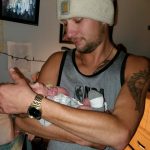
 Riley has grown up so much in the past year. He has a great group of friends, who have been there for him. He has also been blessed with a wonderful girlfriend, Sierah Martin, and her two-year-old son, Jace. Riley loves kids, and was always such a great big brother to his brother, Tucker Schulenberg. They don’t get to see each other as much as they used to, since Tucker lives in Casper, but they are still close. Riley was also blessed this year to become a godparent to a sweet little boy. I think that has been a great honor to him. Today is Riley’s 20th birthday. Happy birthday Riley!! Have a great day!! We love you!!
Riley has grown up so much in the past year. He has a great group of friends, who have been there for him. He has also been blessed with a wonderful girlfriend, Sierah Martin, and her two-year-old son, Jace. Riley loves kids, and was always such a great big brother to his brother, Tucker Schulenberg. They don’t get to see each other as much as they used to, since Tucker lives in Casper, but they are still close. Riley was also blessed this year to become a godparent to a sweet little boy. I think that has been a great honor to him. Today is Riley’s 20th birthday. Happy birthday Riley!! Have a great day!! We love you!!
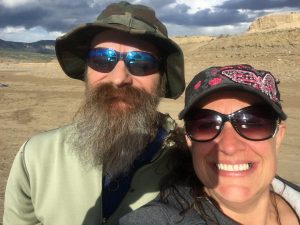
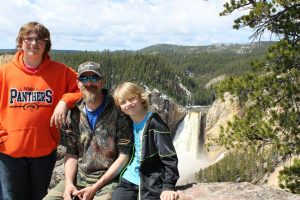 My nephew, Steve Moore loves to go camping in the Big Horn Mountains, and takes his family up there often. They hike the area in search of rocks and artifacts. Steve is an outdoor kind of guy, and is in his element when he is in the great outdoors. It’s not that Steve can’t do other things, but the great outdoors is just where he feels most at home.
My nephew, Steve Moore loves to go camping in the Big Horn Mountains, and takes his family up there often. They hike the area in search of rocks and artifacts. Steve is an outdoor kind of guy, and is in his element when he is in the great outdoors. It’s not that Steve can’t do other things, but the great outdoors is just where he feels most at home.
Steve and my niece, Machelle Moore have two sons…Weston, who is 20 years old; and Easton, who is 16 years old. Of course both boys drive these days, and anyone who has ever owned a vehicle knows that they need occasional maintenance and repair. Most of 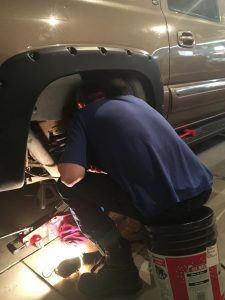
 the time, a vehicle can go a long time before needing repair, but for the Moore family, lately it seems like every vehicle needs something. Steve has been quite busy with multiple maintenance projects of the various vehicles. Unfortunately, while Steve can work on vehicles, he really hates working on vehicles. He has fixed brakes and rotors on the truck he and Machelle own. Then Weston’s new truck needed so work done. After that Easton’s car needed a power steering pump. And just when he thought he was done, Weston’s truck needs work done on the steering and tie rods, because the tires are wearing fast. Then, Steve and Machelle’s other truck needs some work in that sale department, because it’s a little squirrely on the road. Their Tahoe needs the same things as Weston’s vehicle. It’s not as bad as Weston’s, but they need to get it done before they have to get new tires too. They fully understand that vehicles need work, but it would be nice if things to happen one thing
the time, a vehicle can go a long time before needing repair, but for the Moore family, lately it seems like every vehicle needs something. Steve has been quite busy with multiple maintenance projects of the various vehicles. Unfortunately, while Steve can work on vehicles, he really hates working on vehicles. He has fixed brakes and rotors on the truck he and Machelle own. Then Weston’s new truck needed so work done. After that Easton’s car needed a power steering pump. And just when he thought he was done, Weston’s truck needs work done on the steering and tie rods, because the tires are wearing fast. Then, Steve and Machelle’s other truck needs some work in that sale department, because it’s a little squirrely on the road. Their Tahoe needs the same things as Weston’s vehicle. It’s not as bad as Weston’s, but they need to get it done before they have to get new tires too. They fully understand that vehicles need work, but it would be nice if things to happen one thing 
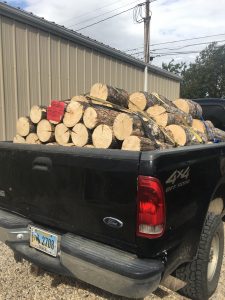 at a time. Thank God, that has been the way it was, or Steve might have been worn out completely.
at a time. Thank God, that has been the way it was, or Steve might have been worn out completely.
In between all the mechanic work, Steve and Machelle have been able to get fire wood this summer. They have been getting wood for Machelle’s parents, LJ and Debbie Cook too. This year they were able to get everybody enough wood to get through the winter, even enough for LJ to hang out in the garage tinkering on his projects; and for them to hang out by their fire pit too. Steve is a great son-in-law, a great husband, and a great dad to his family. Today is Steve’s birthday. Happy birthday Steve!! Have a great day!! We love you!!
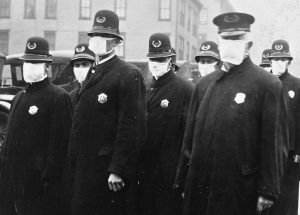 As the Covid-19 Pandemic has spread across our nation, so has the battle for or against the wearing of face masks. Part of the problem has been the conflicting analysis as to the value of the masks between one doctor and another, one politician and another, or even the same doctor at different times during the crisis. Many states, cities, and even establishments have rules about wearing a mask, with varied levels of enforcement. Of course, we were told to “shelter in place” and close any “non-essential” businesses, a catastrophic event for the economy. Everything from schools to bars, and theaters to salons was closed. Cities became virtual ghost towns, and things like Facebook and Twitter, Zoom and Google Classroom, texting and phone calls became vital. People’s sanity began to take a hit, and loneliness became the norm…especially for anyone who lived alone.
As the Covid-19 Pandemic has spread across our nation, so has the battle for or against the wearing of face masks. Part of the problem has been the conflicting analysis as to the value of the masks between one doctor and another, one politician and another, or even the same doctor at different times during the crisis. Many states, cities, and even establishments have rules about wearing a mask, with varied levels of enforcement. Of course, we were told to “shelter in place” and close any “non-essential” businesses, a catastrophic event for the economy. Everything from schools to bars, and theaters to salons was closed. Cities became virtual ghost towns, and things like Facebook and Twitter, Zoom and Google Classroom, texting and phone calls became vital. People’s sanity began to take a hit, and loneliness became the norm…especially for anyone who lived alone.
It’s been a grim time, but it isn’t the first time. During the 1918 Spanish Flu Pandemic, mask wearing started with the first masks being made out of gauze, which was quite porous. Still, in an effort to stop the spread, or as we would say these days, flatten the curve, all the people were now asked to wear masks. In fact, in the Fall of 1918, it became mandatory. With the second surge in December 1918, new restrictions went into place. The January 1919 ordinance had a much larger impact in creating resistance to wearing a mask in public by American citizens. However, it too was short lived, and on February 1, 1919 the city ordinance requiring every citizen of San Francisco going out in public to wear masks was voted down. The mandatory mask laws for COVID-19 are not new. This has already happened twice in American history and if you do feel strongly about not wearing one, it has been protested successfully before in a pandemic caused by a much deadlier virus.
I don’t believe the resistance, with was called the Anti-Mask League of San Francisco fell along party lines, like 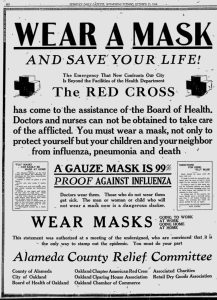 much of today’s resistance seems to be, but were rather a diverse bunch of individuals with varying professional backgrounds. Its members included physicians, libertarians, and many others. Many of the same arguments we have today, were in place then, and it is debatable as to whether or not the masks of today are any better than the ones back then…with the possible exception of the medical grad hazard wear, the N-95 mask, and the Head gear. Pretty much everything we’ve tried with Covic-19 was also used in 1918 to try to prevent the spread of the flu…close schools, wear masks, don’t cough or sneeze in someone’s face, avoid large events and hold them outside when possible, and of course, no spitting. There were many ways to get the word out, like in Philadelphia, where streetcar signs warned “Spit Spreads Death.” In New York City, officials enforced no-spitting ordinances and encouraged residents to cough or sneeze into handkerchiefs (a practice that caught on after the pandemic). The city’s health department even advised people not to kiss “except through a handkerchief,” and wire reports spread the message around the country. I don’t know…does any of this sound familiar to you, because it sure does to me. I guess there really is nothing new under the sun. In western states, some cities even called mask ordinances a patriotic duty. In October 1918, the San Francisco Chronicle ran a public service announcement telling readers that “The man or woman or child who will not wear a mask now is a dangerous slacker.” This was in reference to the type of World War I “slacker” who didn’t help the war effort. One sign in California threatened, “Wear a Mask or Go to Jail.” The PSA in the Chronicle appeared on October 22, just over a week before San Francisco had scheduled its mask ordinance to begin on November 1. It was signed by the mayor, the city’s board of health, the American Red Cross and several other departments and organizations, and it was very clear about its message: “Wear a Mask and Save Your Life!”
much of today’s resistance seems to be, but were rather a diverse bunch of individuals with varying professional backgrounds. Its members included physicians, libertarians, and many others. Many of the same arguments we have today, were in place then, and it is debatable as to whether or not the masks of today are any better than the ones back then…with the possible exception of the medical grad hazard wear, the N-95 mask, and the Head gear. Pretty much everything we’ve tried with Covic-19 was also used in 1918 to try to prevent the spread of the flu…close schools, wear masks, don’t cough or sneeze in someone’s face, avoid large events and hold them outside when possible, and of course, no spitting. There were many ways to get the word out, like in Philadelphia, where streetcar signs warned “Spit Spreads Death.” In New York City, officials enforced no-spitting ordinances and encouraged residents to cough or sneeze into handkerchiefs (a practice that caught on after the pandemic). The city’s health department even advised people not to kiss “except through a handkerchief,” and wire reports spread the message around the country. I don’t know…does any of this sound familiar to you, because it sure does to me. I guess there really is nothing new under the sun. In western states, some cities even called mask ordinances a patriotic duty. In October 1918, the San Francisco Chronicle ran a public service announcement telling readers that “The man or woman or child who will not wear a mask now is a dangerous slacker.” This was in reference to the type of World War I “slacker” who didn’t help the war effort. One sign in California threatened, “Wear a Mask or Go to Jail.” The PSA in the Chronicle appeared on October 22, just over a week before San Francisco had scheduled its mask ordinance to begin on November 1. It was signed by the mayor, the city’s board of health, the American Red Cross and several other departments and organizations, and it was very clear about its message: “Wear a Mask and Save Your Life!”
“Red Cross headquarters in San Francisco made 5,000 masks available to the public at 11:00am, October 22. By noon it had none,” wrote the late historian Alfred W Crosby in America’s Forgotten Pandemic: The Influenza of 1918. “By noon the next day Red Cross headquarters had dispensed 40,000 masks. By the twenty-sixth 100,000 had been distributed in the city… In addition, San Franciscans were making thousands for themselves.” Lasting from February 1918 to April 1920, the Spanish Flu Pandemic infected 500 million people…about a third  of the world’s population at the time, in four successive waves. The death toll is typically estimated to have been somewhere between 17 million and 50 million, and possibly as high as 100 million, making it one of the deadliest pandemics in human history. With all the safeguards, and the lack of success in “stopping the spread,” I guess it is up to each individual to decide on the effectiveness, or the lack thereof, concerning the safeguards that were put in place. To me, it seems that we have done pretty much the same things today as they did in 1918, so only time will tell us if they were successful, or a waste of time and money. Still, since the Spanish Flue had 4 waves, it doesn’t seem like we successfully stopped anything.
of the world’s population at the time, in four successive waves. The death toll is typically estimated to have been somewhere between 17 million and 50 million, and possibly as high as 100 million, making it one of the deadliest pandemics in human history. With all the safeguards, and the lack of success in “stopping the spread,” I guess it is up to each individual to decide on the effectiveness, or the lack thereof, concerning the safeguards that were put in place. To me, it seems that we have done pretty much the same things today as they did in 1918, so only time will tell us if they were successful, or a waste of time and money. Still, since the Spanish Flue had 4 waves, it doesn’t seem like we successfully stopped anything.
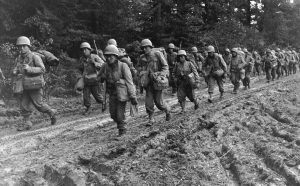
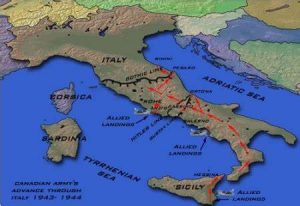 During World War II, when Japan was the enemy, and the United States just happened to have a Japanese population of between 110,000 and 120,000 people of Japanese ancestry. The government decided to place these people in internment camps, mainly because they were not sure of their loyalty. Sixty-two percent of the internees were United States citizens, but somehow that didn’t matter. The American people and the government were afraid of them. Maybe it made no sense, but there it was.
During World War II, when Japan was the enemy, and the United States just happened to have a Japanese population of between 110,000 and 120,000 people of Japanese ancestry. The government decided to place these people in internment camps, mainly because they were not sure of their loyalty. Sixty-two percent of the internees were United States citizens, but somehow that didn’t matter. The American people and the government were afraid of them. Maybe it made no sense, but there it was.
While their families were interned in camps at home, a group of Japanese-Americans, were serving their country as members of the 100th Infantry Battalion and the 442nd Infantry Regiment. The 100th Infantry Battalion was composed mainly of Nisei…the American born children of Japanese immigrants. They were fighting for the allies on the Western Front of World War II. While the American people did not trust the Japanese immigrants or their children, this unit, out of all units of comparable size and length of service, the 442nd Regimental Combat Team (RCT) is, to this day, the most decorated unit in American military history.
Most of the men in the 100th Infantry Battalion were former Nisei members from the Hawaii National Guard. These brave men fought to capture the fortress of Monte Cassino in Italy. It was in this battle that the 100th Infantry Battalion first earned the nickname “Purple Heart Battalion.” The battle to capture the fortress of Monte Cassino was an important stage in the offensive to liberate Rome from Axis leaders. The 100th Infantry Battalion later became incorporated into the 442nd RCT, which drew most of its forces from mainland Nisei volunteers, after the regiment arrived in Europe.
During the war, one battle stood out…at least in my mind. It was one that proves without a doubt, the extreme loyalty and courage of this unit. Among their other military accomplishments, the 442nd RCT was instrumental in the rescue of the “Lost Battalion.” In a daring last-ditch effort, members of the 442nd RCT were ordered to rescue a battalion of Texans surrounded by German troops in the Vosges Mountains of eastern France. Although the Nisei knew that they would suffer heavy casualties, many saw the mission as a chance to prove their loyalty. The regiment was also critical in the breach of the Gothic Line. Embedded within the Apennine 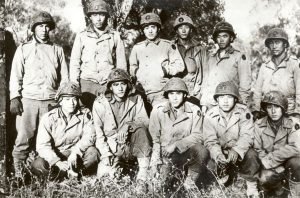
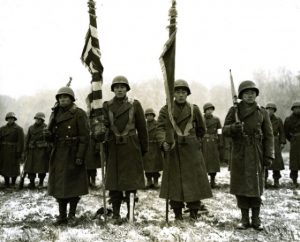 Mountains, it was Germany’s last major line of defense in the Italian Campaign. Later, members of the regiment were present at the liberation of the infamous Dachau concentration camp in Germany. For some of the soldiers, the experience was a bittersweet one; although they were able to emancipate the prisoners of the camp, they could not help but remember their detained families at home.
Mountains, it was Germany’s last major line of defense in the Italian Campaign. Later, members of the regiment were present at the liberation of the infamous Dachau concentration camp in Germany. For some of the soldiers, the experience was a bittersweet one; although they were able to emancipate the prisoners of the camp, they could not help but remember their detained families at home.
 I am always amazed at the lengths nations will go to try to have a better weapon with which to war against their enemies. Some of the weapons were horrifically great successes, while others only succeeded in being amusingly unsuccessful. It seems that the Germans were famous for trying to come up with unusual ideas for weaponry. In fact, World War II seemed to be full of bizarre weapons.
I am always amazed at the lengths nations will go to try to have a better weapon with which to war against their enemies. Some of the weapons were horrifically great successes, while others only succeeded in being amusingly unsuccessful. It seems that the Germans were famous for trying to come up with unusual ideas for weaponry. In fact, World War II seemed to be full of bizarre weapons.
Wars always present opportunities for technological development, but Germany seemed to be particularly motivated to pour considerable resources into weapons projects. The level of success, varied with the weapons. That is not unusual, as weapons go, but I think that when you look some of the bizarre weapon designs that Germany came up with really seemed like a recipe for calamity to me. The weapons they came up with had varying degrees of success. The Germans developed the V-2 rocket, which both rained destruction on the United Kingdom and jumpstarted the space race. On the other hand, they also tried to build a “sun gun,” an orbital heat ray that was supposed to use reflected sunlight to torch cities.
The V-3 cannon project falls in the middle of the spectrum of weaponry. In the end, it never threatened the Allied powers, but if it had been given more production time, it very well could have. The V-3 was an extremely long artillery piece, over 430 feet in length. It was designed to fire projectiles up to a distance of 100 miles away. The V-3 cannon was built to bombard British cities from mainland Europe, bypassing the need for planes or the V-2. These enormous guns had been in development since World War I, on both sides of the conflict, but to this point these weapons hadn’t been deployed in combat. The problem was that the size of an explosion needed to propel a projectile over such a distance was so large that it would quickly destroy any gun barrel. They just couldn’t get that part fixed.
At the outbreak of World War II, the Germans rediscovered the plans for the V-3 and began to research them 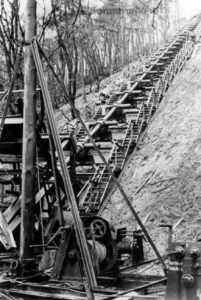 again. In 1943, Hitler restarted the V-3 project under his Armaments and War Procurement Minister, Albert Speer. The first goal was to solve the explosion problem. It was decided that the V-3 would use several small explosions that would propel the projectile along the barrel. Even with that change, the barrel was so large and unwieldy that it couldn’t be aimed. It had to be built already aiming at the intended target, and the target had to be the size of a city. That is a tall order.
again. In 1943, Hitler restarted the V-3 project under his Armaments and War Procurement Minister, Albert Speer. The first goal was to solve the explosion problem. It was decided that the V-3 would use several small explosions that would propel the projectile along the barrel. Even with that change, the barrel was so large and unwieldy that it couldn’t be aimed. It had to be built already aiming at the intended target, and the target had to be the size of a city. That is a tall order.
The Germans made plans to build 50 V-3 cannons on the French coastline, but RAF bombings delayed the project. When the Allies retook France in 1944, the V-3 project was again abandoned. The Allies didn’t learn of the V-3 project until after World War II had ended. Winston Churchill said that “if the guns had been completed, they could have devastated England more than any other German weapon.” Thankfully the Allies retook France in time to avoid such a disaster.
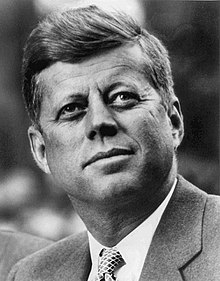
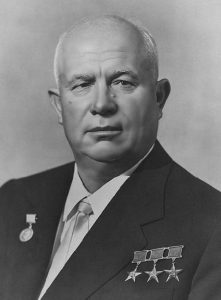 For anyone alive and of an age to remember it, the 1950s and 1960s brought with them a strange new reality. I can’t say that I fully understood it all at that time, but I remember our school having a “Fallout Shelter.” They were also called a “Bomb Shelter” in some places, and the purpose was to protect the population from exposure to the fallout from a nuclear explosion. I suppose that if I had understood more about what these were, I might have been scared, but I just remember thinking it a strange idea, and highly unlikely. It did occur to me that if a bomb to explode, it would be unlikely that we would all have time to get to the school for protection.
For anyone alive and of an age to remember it, the 1950s and 1960s brought with them a strange new reality. I can’t say that I fully understood it all at that time, but I remember our school having a “Fallout Shelter.” They were also called a “Bomb Shelter” in some places, and the purpose was to protect the population from exposure to the fallout from a nuclear explosion. I suppose that if I had understood more about what these were, I might have been scared, but I just remember thinking it a strange idea, and highly unlikely. It did occur to me that if a bomb to explode, it would be unlikely that we would all have time to get to the school for protection.
Apparently, President John F. Kennedy, agreed with me on that thought, because, when he was speaking on civil defense on October 6, 1961, he advised American families to build bomb shelters to protect them from atomic fallout in the event of a nuclear exchange with the Soviet Union. We were, after all, in the middle of the Cold War, and neither side really knew if the other side would decide that they needed to start that latest, deadly type of war with the other side. Looking back, many people aren’t sure that a home-made bomb shelter would really be able to protect the occupants from the fallout of an atomic bomb. No one can really say for sure that the government-built shelters in schools and churches could either, in retrospect.
Still, prudent minds assumed that something needed to be done. Kennedy also assured the public that the United States civil defense program would soon begin providing such protection for every American. What seemed like science fiction, became a grim possibility just one year later, when true to Kennedy’s concerns, the world hovered on the brink of full-scale nuclear war when the Cuban Missile Crisis erupted over placement of nuclear missiles in Cuba by the USSR. Of course, panic ensues. The crisis lasted for 13 days, but some Americans prepared for nuclear war by buying up canned goods and completing last-minute work on their backyard bomb shelters. In the end, of course, it all ended without. After several days of tense negotiations, Kennedy and Khrushchev reached an agreement. Publicly, the Soviets would dismantle their offensive weapons in Cuba and return them to the Soviet Union, subject to United Nations verification, in exchange for a US public 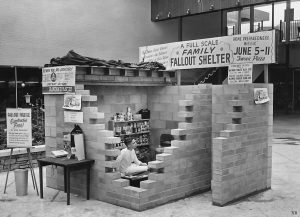
 declaration and agreement to avoid invading Cuba again. The Kennedy administration had been publicly embarrassed by the failed Bay of Pigs Invasion in April 1961, which had been launched under President John F Kennedy by CIA-trained forces of Cuban exiles. Afterward, former President Dwight Eisenhower told Kennedy that “the failure of the Bay of Pigs will embolden the Soviets to do something that they would otherwise not do.” He was right, but for now, disaster was averted.
declaration and agreement to avoid invading Cuba again. The Kennedy administration had been publicly embarrassed by the failed Bay of Pigs Invasion in April 1961, which had been launched under President John F Kennedy by CIA-trained forces of Cuban exiles. Afterward, former President Dwight Eisenhower told Kennedy that “the failure of the Bay of Pigs will embolden the Soviets to do something that they would otherwise not do.” He was right, but for now, disaster was averted.
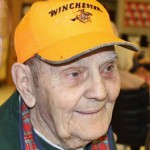
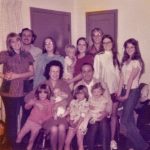 My uncle, Lester “Jim” Wolfe was always a crazy guy…in a good way, of course. He loved to play tricks on people, but always in good fun. Whenever he and my dad, Al Spencer got together, you knew that they were going to do the craziest of things. I don’t remember all the antics these brother-in-law pulled, not the crazy food they made, like onion and mustard sandwiches.
My uncle, Lester “Jim” Wolfe was always a crazy guy…in a good way, of course. He loved to play tricks on people, but always in good fun. Whenever he and my dad, Al Spencer got together, you knew that they were going to do the craziest of things. I don’t remember all the antics these brother-in-law pulled, not the crazy food they made, like onion and mustard sandwiches.
Uncle Jim and Aunt Ruth were always the kind of people who liked surprises. Often, they would show up at our house unannounced…from several states away, mind you. I suppose that it was a risky maneuver, from the aspect of making that long trip without getting to see the people they came to see. If we were out of town when they showed up, they never told us they had missed us. I’m not sure how they managed to find us home when they came, because our family often took trips too. My dad and his sister, Ruth had always loved to see the nation, and both did a lot of traveling in their day. When they showed up at our house, it was cause for celebration. It was just like coming home to a surprise party!! One surprise on Uncle Jim in his life was that his son-in-law, Wayne “Shorty” Cameron shared his birthday with him. I’m sure Uncle Jim liked that very much.
While they were here, we might go camping, have barbecues, or just hang out. It didn’t really matter what we 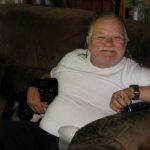
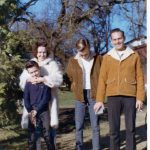 did, because having them here made things more fun. We also loved seeing our cousins in the early years, but as they got older, it was often just Uncle Jim and Aunt Ruth that came. Our own lives got busier too, of course. Marriages and kids made it harder to spend as much time with them on those visits as we used to. Still, when they were in town, we spent as much time with them as we could. I miss those days. Today would have been Uncle Jim’s 99th birthday, and Shorty’s 79th birthday. Happy birthday in Heaven Uncle Jim and Shorty. We love and miss you both very much.
did, because having them here made things more fun. We also loved seeing our cousins in the early years, but as they got older, it was often just Uncle Jim and Aunt Ruth that came. Our own lives got busier too, of course. Marriages and kids made it harder to spend as much time with them on those visits as we used to. Still, when they were in town, we spent as much time with them as we could. I miss those days. Today would have been Uncle Jim’s 99th birthday, and Shorty’s 79th birthday. Happy birthday in Heaven Uncle Jim and Shorty. We love and miss you both very much.

